Friday, August 25, 2006
Æ25, Nicaea in Bithynia, Gallienus, Lindgren III, 199var..
(legend break)
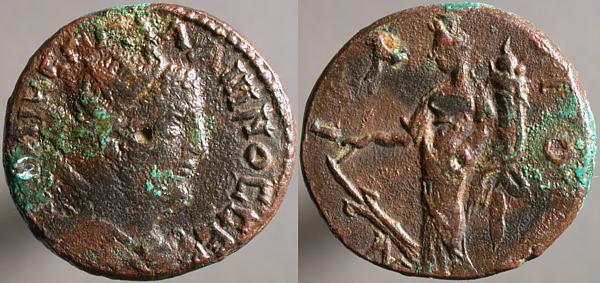
[Π]O ΛIK EΓ ΓAΛΛIHNOC CE, Radiate draped cuirassed bust right | N_IKA_IEΩN, Tyche standing left, holding cornucopia right and rudder left.
This was, of course, minted during the reign of Gallienus (253-268). In 325, diring the reign of Constantine, the mint city, Nicaea hosted the first of the councils that formalized the nature of the Christian godhead and established answers to a variety of other other questions.

[Π]O ΛIK EΓ ΓAΛΛIHNOC CE, Radiate draped cuirassed bust right | N_IKA_IEΩN, Tyche standing left, holding cornucopia right and rudder left.
This was, of course, minted during the reign of Gallienus (253-268). In 325, diring the reign of Constantine, the mint city, Nicaea hosted the first of the councils that formalized the nature of the Christian godhead and established answers to a variety of other other questions.
Thursday, August 24, 2006
Æ antoninianus, Gallienus, Samosata, Göbl 1702b(2)
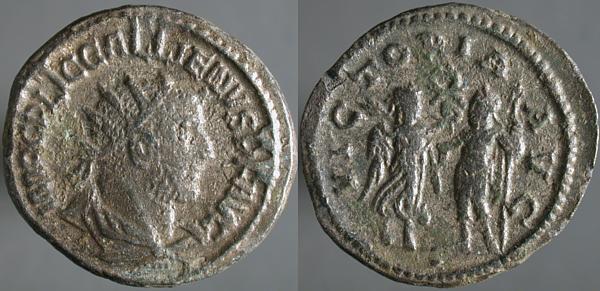
IMP C P LIC GALLIENVS P F AVG, Radiate draped cuirassed bust right | VICTORIA AVG, To right, Roma seated left on shield, with spear in left hand, with right hand presenting Victory to emperor, who stands to her right. Wreath above, pellet in exergue.
After a bit of practice, each mint that issue Imperial coins for Gallienus has distinctive characteristics, even if they're not easy to verbalize. Samosata, mow drowned behind Turkey's Atatürk Dam, tended towards coarse portraits and reverses that almost always feature two figures even if, as here, a man-shaped trophy was used in the place of one figure.
Wednesday, August 23, 2006
Æ3/4, Valentinian I, Siscia, LRBC II,1294
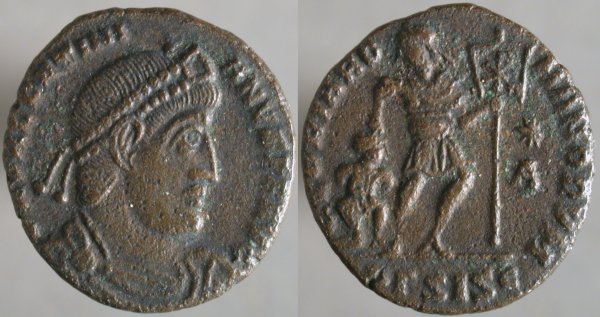
D N VALENTINIANVS P F AVG, Pearl-diademed draped bust right | GLORIA ROMANORVM, Emperor with chi-rho labarum, dragging captive right, Star over A in right field, ΓSISC in exergue.
The Praetorian Flavius Valentinianus became emperor on the death of Jovian in 364. After appointing his brother Valens as emperor with him, Valentinian spent the next 11 years defending the borders of his realm, and enhancing the legal position of his infantry and cavalry officers.
Valentinian died in 375, commonly said to have suffered a stroke during a foot-stomping monkey-faced livid rage after not getting exactly his own way immediately.
Update: Fixed spelling of labarum.
Tuesday, August 22, 2006
Æ28, Irenopolis in Cilicia, Valerian, SNG von Aulock 5598
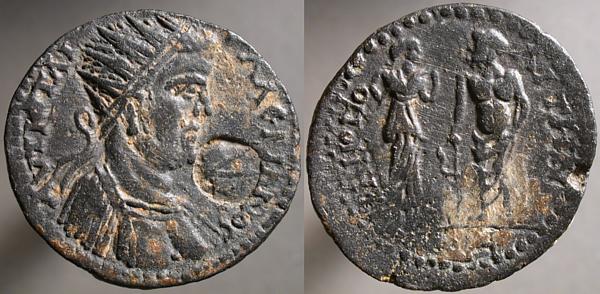
AVT K Π ΛI VAΛE[...]AN[...], Radiate cuirassed bust right | IPHNIOΠ_O_ΛITΩN ΔC, Hygieia, left, standing facing Aesculapius who holds a snake-entwined staff.
I have three examples of this coin, each with a different counterstamp. None is worn as though it had circulated for decades before being counterstamped, as is sometimes seen on provincial bronzes of the Julio-Claudians, counterstamped to assign a value to otherwise obsolete coins, nor as it an obvious mark of denomination such as many coins from Third-century Pamphylia used, apparently from the time they were minted, to provide small change by obliterating the mark of higher value already present on the die.
I don't know what Irenopolis was up to here.
Monday, August 21, 2006
Silvered Æ antoninianus, Gallienus, Siscia, Göbl 1476p
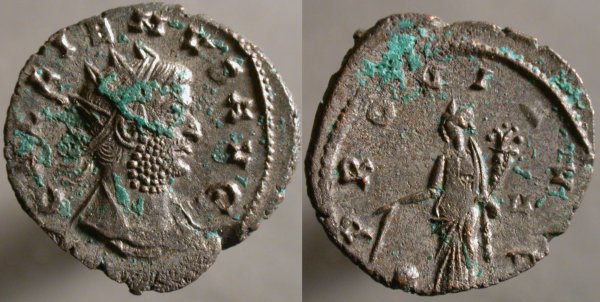
GALLIENVS AVG, Radiate draped cuirassed bust right | PROVI AVG, Providentia standing left, holding overflowing cornucopia right and pointing down at globe with baton left. II in right field.
Gold is the least reactive metal commonly used in coinage and silver the next least, although these metals are no longer generally used for real circulating coinage.
Bronze, used for this coin, is a far more reactive metal, apparently eager to form chemical compounds with suitable chemicals in the environment. The green material on the surfaces here are such compounds and if the material could be removed without otherwise disturbing the coin, that would probably reveal some pits where the bronze that was part of the coin when it was new has been consumed in making the green material.

